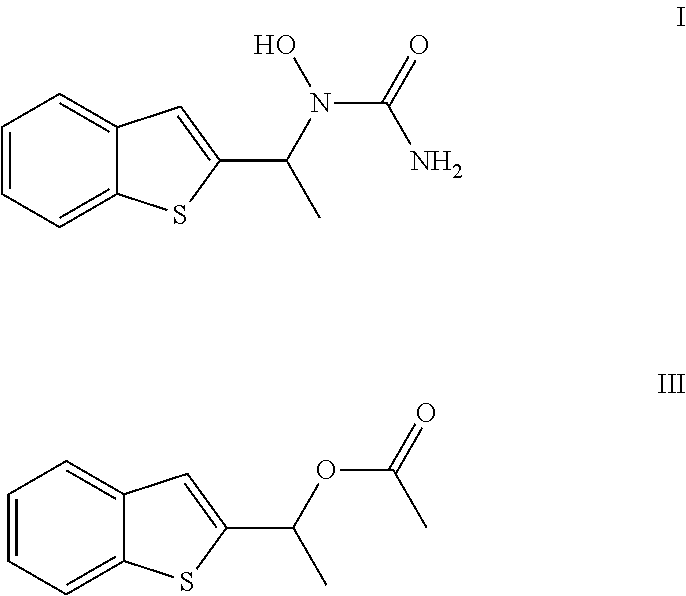Process for the Preparation of Zileuton
a technology of zileuton and process, applied in the field of process for the preparation of zileuton, can solve the problems of cumbersome purification process, high cost, toxic and expensive process,
- Summary
- Abstract
- Description
- Claims
- Application Information
AI Technical Summary
Benefits of technology
Problems solved by technology
Method used
Image
Examples
example-1
Preparation of 1-Benzo[b]thiophen-2-yl-ethanol (II)
[0110]An aqueous solution of sodium borohydride[Sodium borohydride (15.3 gm) dissolved in water (60 ml)] was added to a slurry of 2-acetyl benzothiophene (100 gm) and methanol (300 ml) and cooled at 5-10° C. and maintained for 2 hrs at the same temperature. The progress of the reaction was monitored by HPLC. After completion of the reaction, the pH of the reaction mass was adjusted to 7.0-7.5 using Con. HCl and distilled under the reduced pressure. The resultant mass was added into water (700 ml) and stirred for 2 hrs. The resultant solid was filtered and washed with water (200 ml). % Yield: 90%.
example-2
Preparation of Acetic acid 1-benzo[b]thiophen-2-yl-ethyl ester (III)
[0111]The solid obtained in example-1 (1-Benzo[b]thiophen-2-yl-ethanol) was dissolved in 900 ml of toluene, followed by the addition of water. The toluene layer was separated from the resultant biphasic mixture, and washed with 10% brine solution (750 ml). The washed toluene layer was cooled to 0-5° C. and followed by the addition of triethyl amine (187.6 ml) and dimethylaminopyridine (DMAP) (5.14 gm). Acetic anhydride (120 ml) was slowly added to the resultant reaction mixture and stirred for 2 hrs at 25-30° C. The progress of the reaction was monitored by HPLC. After completion of the reaction, the reaction mass was washed with water (750 ml); then with 10% acetic acid (750 ml) and followed by 10% of brine solution (750 ml). The resultant organic phase is taken for the next step without isolation. % Yield: 95%
example 3
Preparation of N-(phenyl hydroxyl carbamate) (IV)
[0112]Sodium bicarbonate (128.7 gm) was added to aqueous solution of hydroxylamine hydrochloride [hydroxylamine hydrochloride (50.0 gm) in water (400 ml)] at 30° C. followed by ethyl acetate (600 ml) and cooled to 5-10° C. To this mixture phenyl chloroformate (100 gm) was added slowly at 5-10° C. and stirred for about 2 hrs for 30° C. The progress of the reaction was monitored by HPLC. After completion of the reaction, ethyl acetate layer was separated and distilled under reduced pressure to an oily mass. The oily mass was mixed with cyclohexane (600 ml) at 60° C. and distilled out at 75-80° C. The resultant mass brought to 30° C., then stirred for about 2 hrs. The resulted solid was filtered, washed with cyclohexane (200 ml) and dried under vacuum. Yield: 85%.
PUM
 Login to View More
Login to View More Abstract
Description
Claims
Application Information
 Login to View More
Login to View More - R&D
- Intellectual Property
- Life Sciences
- Materials
- Tech Scout
- Unparalleled Data Quality
- Higher Quality Content
- 60% Fewer Hallucinations
Browse by: Latest US Patents, China's latest patents, Technical Efficacy Thesaurus, Application Domain, Technology Topic, Popular Technical Reports.
© 2025 PatSnap. All rights reserved.Legal|Privacy policy|Modern Slavery Act Transparency Statement|Sitemap|About US| Contact US: help@patsnap.com



